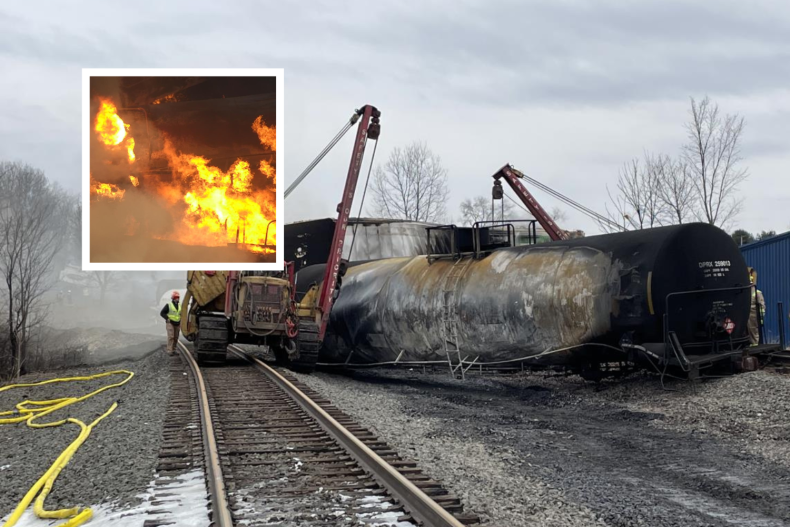Months After Ohio Derailment: The Ongoing Threat Of Toxic Chemicals

Table of Contents
Health Impacts of the Ohio Derailment's Toxic Chemicals
The release of toxic chemicals, including vinyl chloride and butyl acrylate, poses significant immediate and long-term health risks to residents of East Palestine and surrounding areas. Vinyl chloride, a known carcinogen, is linked to an increased risk of several cancers, including liver, lung, and brain cancer. Butyl acrylate, another hazardous chemical, can cause respiratory irritation, skin sensitization, and eye damage.
- Increased rates of respiratory illnesses: Reports indicate a surge in respiratory problems, including coughing, wheezing, and shortness of breath, among residents following the derailment.
- Long-term studies needed to assess carcinogenic risks: The long latency period for many cancers means that the full carcinogenic impact of this toxic chemical exposure may not be apparent for years, necessitating comprehensive and long-term health monitoring.
- Concerns about reproductive health and developmental impacts on children: Exposure to dangerous chemicals during pregnancy and early childhood can have devastating consequences on reproductive health and fetal development. Further research is crucial to assess the extent of these impacts.
- Mental health impacts of the disaster and uncertainty: The stress and anxiety caused by the derailment, the evacuation, and the uncertainty surrounding long-term health risks have significantly impacted the mental health of the community.
Environmental Contamination from Released Toxic Chemicals
The environmental consequences of the derailment are equally alarming. The spilled toxic chemicals contaminated soil, water, and air, creating a wide-ranging environmental disaster. The extent of the contamination is still being assessed, but initial findings are deeply troubling.
- Contamination of drinking water sources: Concerns remain regarding the potential long-term contamination of local water supplies, impacting both human health and the local ecosystem.
- Impact on local agriculture and food production: The contamination poses a significant threat to local agriculture and food production, potentially affecting the safety and viability of crops and livestock.
- Loss of biodiversity due to chemical exposure: The released hazardous chemical exposure has already affected local wildlife, causing potential long-term impacts on biodiversity and ecosystem health.
- Long-term monitoring needed to assess environmental recovery: Ongoing monitoring is essential to track the spread of contamination, assess the effectiveness of cleanup efforts, and predict the long-term ecological recovery of the affected area.
Government Response and Accountability for Toxic Chemicals
The government's response to the derailment has faced considerable criticism. While cleanup efforts have begun, concerns remain about the speed, transparency, and overall effectiveness of the initial response. The lack of immediate and comprehensive communication with residents also added to public anxiety and distrust.
- Criticism of the initial response speed and transparency: The initial response was criticized for its slow pace and lack of transparency, leaving residents feeling abandoned and uninformed.
- Ongoing investigations into the cause of the derailment: Investigations are ongoing to determine the exact cause of the derailment and identify any contributing factors that could have been prevented.
- Legal actions against the railroad company and other involved parties: Several lawsuits have been filed against the railroad company and other involved parties, seeking accountability for the damages caused by the toxic chemical spill.
- Need for stronger regulations and safety measures to prevent future incidents: The derailment underscores the urgent need for stronger regulations and safety measures to prevent similar incidents involving the transportation of toxic chemicals in the future.
Long-Term Cleanup and Monitoring of Toxic Chemicals
The long-term cleanup and monitoring process will be a complex and costly undertaking. The sheer scale of the contamination, the potential for long-term health problems, and the complexities of remediating contaminated soil and water present significant challenges.
- Soil remediation techniques being employed: Various soil remediation techniques are being employed, but the effectiveness and long-term impacts of these methods remain uncertain.
- Water treatment and purification efforts: Extensive efforts are underway to treat and purify contaminated water sources, ensuring safe and reliable access to clean drinking water for residents.
- Long-term health monitoring programs for residents: A comprehensive long-term health monitoring program is crucial to track health outcomes and provide appropriate medical care to those affected by the hazardous chemical exposure.
- Economic impacts of the disaster and cleanup efforts: The economic impact of the disaster extends beyond immediate costs, potentially affecting local businesses, agriculture, and property values for years to come.
The Continuing Threat of Toxic Chemicals and the Need for Action
The Ohio train derailment serves as a stark reminder of the potential devastation caused by the release of toxic chemicals. The long-term health, environmental, and economic consequences of this disaster will be felt for years, underscoring the urgent need for continued monitoring, cleanup efforts, and comprehensive health support for the affected communities. We must demand stronger regulations and improved safety standards to prevent future incidents involving the transport of dangerous chemicals. Stay informed, support affected communities, and demand accountability from those responsible for this devastating toxic chemical spill. Only through collective action can we mitigate the ongoing threat posed by the improper handling of dangerous chemicals and prevent similar tragedies from occurring in the future.

Featured Posts
-
 Aaron Judge And Samantha Bracksieck Welcome First Child
Apr 28, 2025
Aaron Judge And Samantha Bracksieck Welcome First Child
Apr 28, 2025 -
 Market Volatility Examining The Actions Of Professionals And Individuals
Apr 28, 2025
Market Volatility Examining The Actions Of Professionals And Individuals
Apr 28, 2025 -
 Office365 Exec Inbox Breaches Net Millions For Crook Fbi Says
Apr 28, 2025
Office365 Exec Inbox Breaches Net Millions For Crook Fbi Says
Apr 28, 2025 -
 Analysis Of Musks X Debt Sale Impact On Company Financials
Apr 28, 2025
Analysis Of Musks X Debt Sale Impact On Company Financials
Apr 28, 2025 -
 The Luigi Mangione Movement Understanding Its Core Beliefs
Apr 28, 2025
The Luigi Mangione Movement Understanding Its Core Beliefs
Apr 28, 2025
